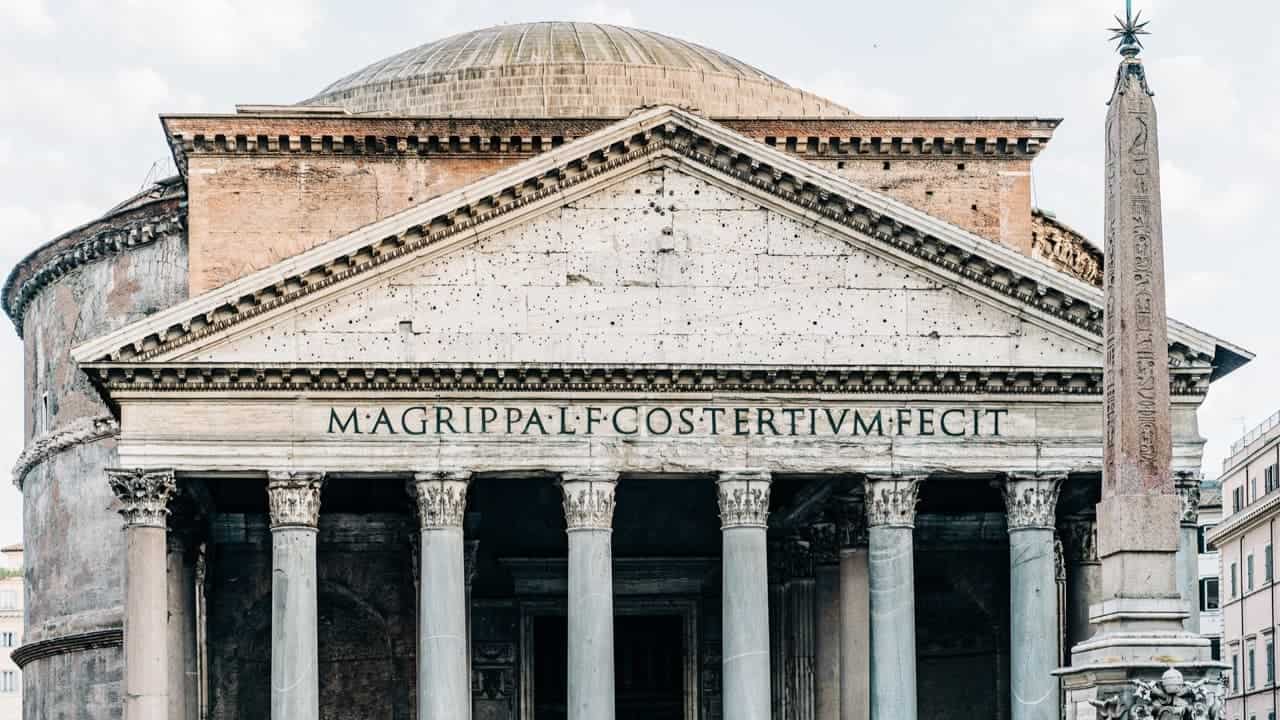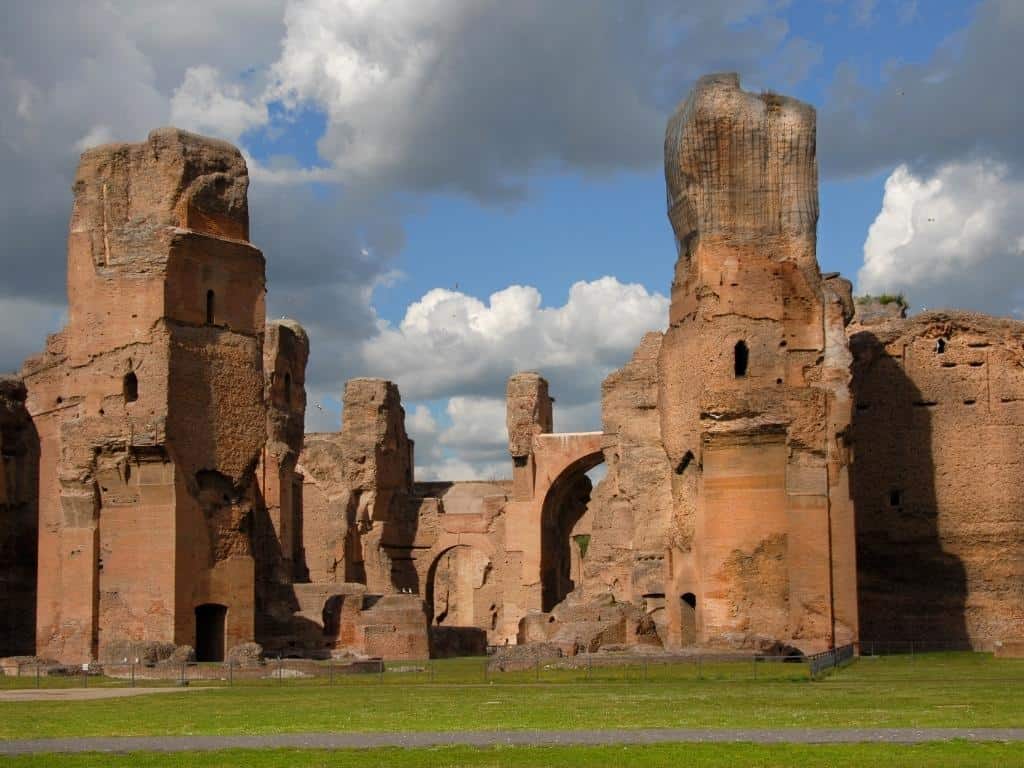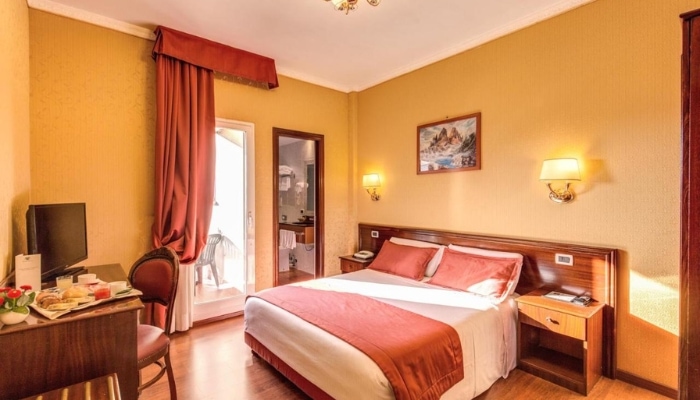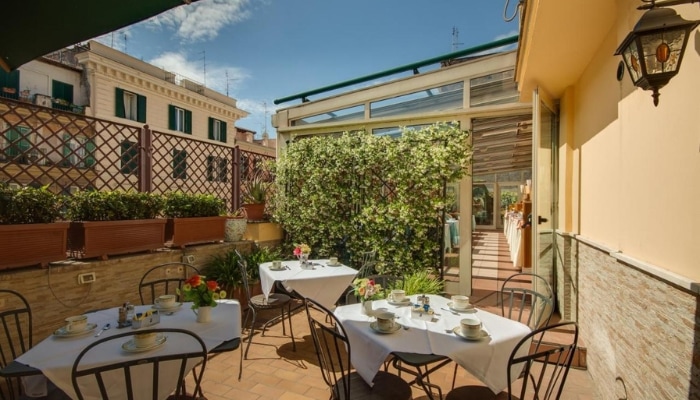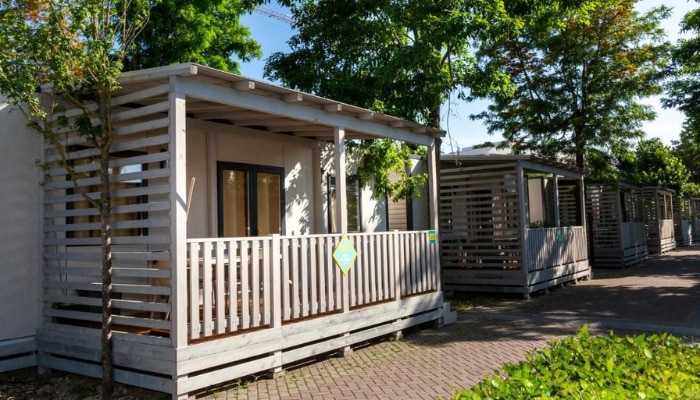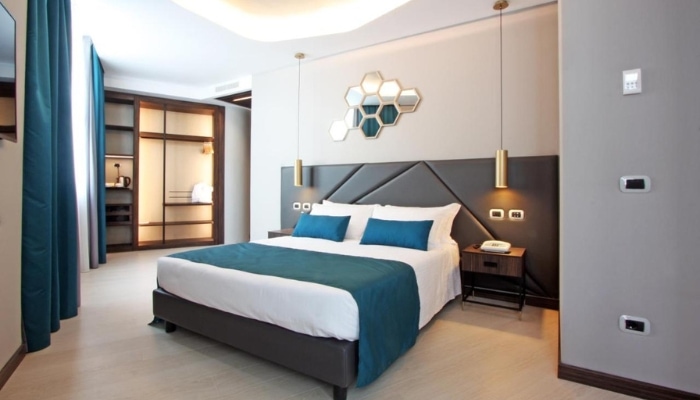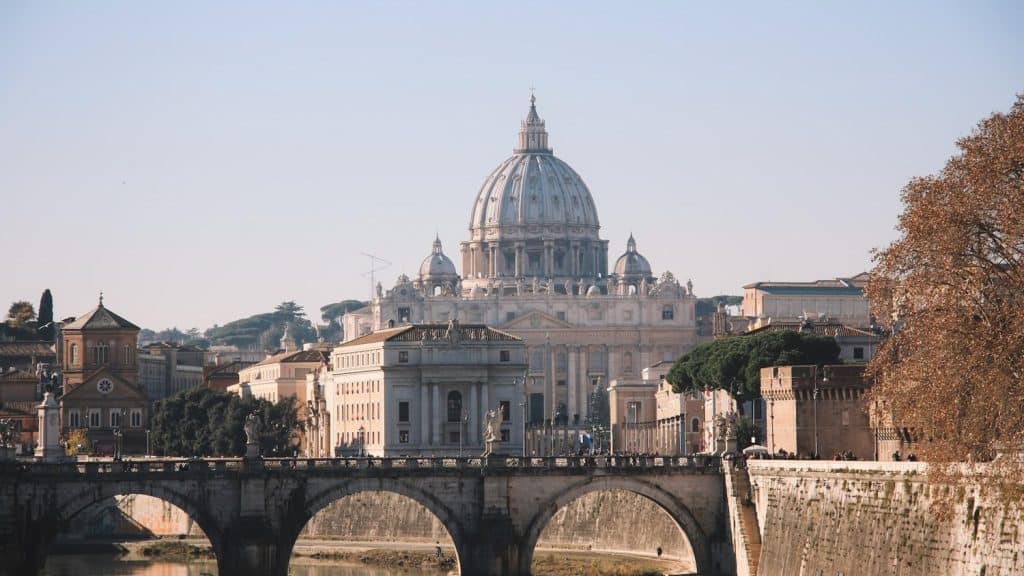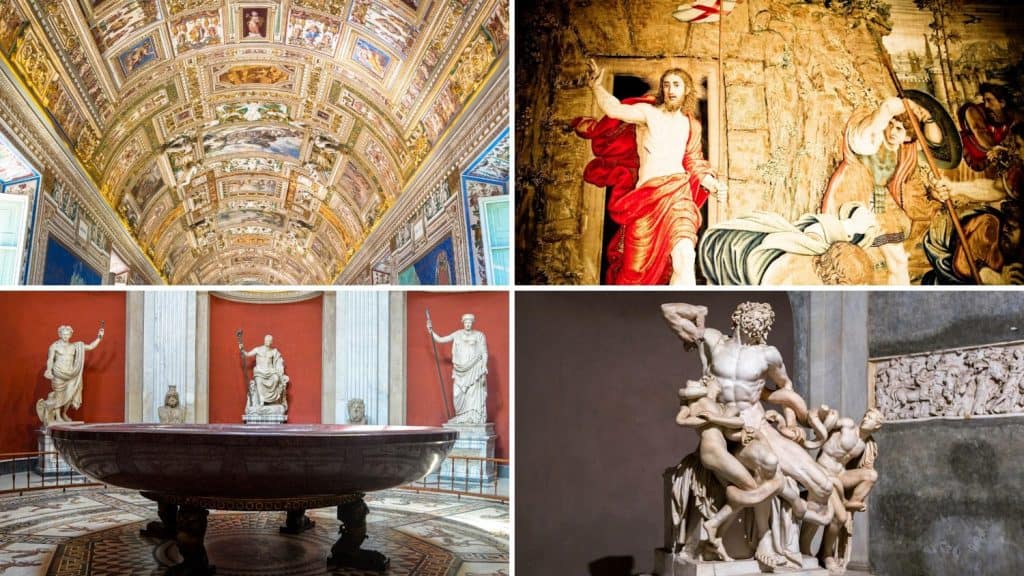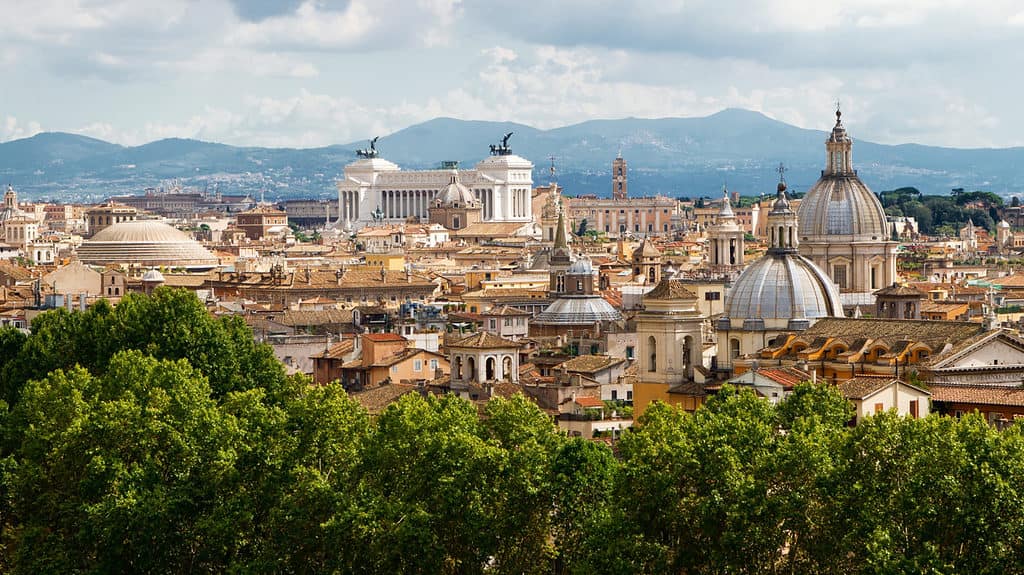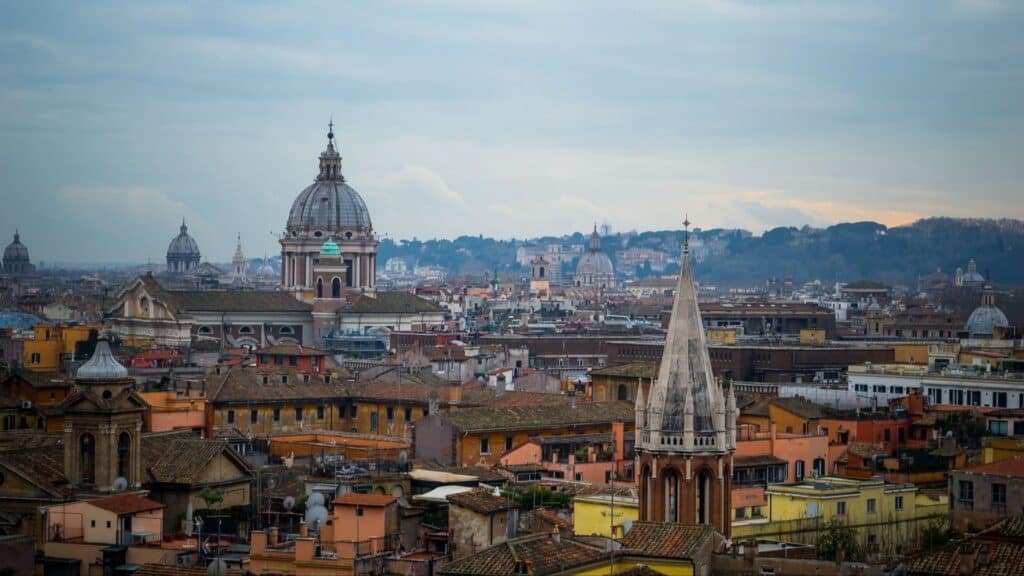The sights of ancient Rome were what we were most looking forward to on our first visit to Rome. And the other one, too.
One is amazed at the sight of them. How could anyone have created something as impressive as the Colosseum or Trajan’s Markets back then? How did the public life in the Forum Romanum, which was watched by the nobility from Palatine Hill, go? Discovering Rome’s long history is all the more fun.
If you’re like us, check out our 14 tips for sights in ancient Rome.
- How to enjoy a visit to Rome
- Which monuments of ancient Rome are worth a visit?
- Colosseum
- Palatine's hill
- Forum Romanum
- Arch of Constantine
- Circus Maximus
- Baths od Caracalla (Terme di Caracalla)
- Trajan's Forum – Museo dei Fori Imperiali
- Angel Castle and Angel Bridge
- Pantheon
- Sacra di Largo Argentina
- Diocletian's Baths
- Basilica of Santa Maria Maggiore
- Via Appia Antica
- Catacombs of Rome (Catacombe di Roma)
- Ticket Reservation
- Monuments of Ancient Rome – MAP
- Where to stay in Rome
- More about Rome
How to enjoy a visit to Rome
If you don’t want to spend hours waiting, book tickets for the most popular sites in advance – you’ll find specific tips and links for booking tickets for the sights below.
Book your accommodation near Termini Station, where you can reach the airport and be just a short walk from the centre of Rome. The best hotels near Termini Station include:
- Hotel Borromeo – cosy period rooms with private bathrooms and air conditioning (for 2-4 people); a few minutes from the metro and within walking distance of the historic centre; beautiful roof terrace with seating and sun loungers
- The Hive hotel – trendy hotel with modern and clean rooms; rooms and suites for up to 4 people available; spacious roof terrace with seating and restaurant
- Hotel Impero – cheap hotel with excellent breakfast and roof terrace; older facilities but clean and cosy; quiet at night
- hu Roma Camping in Town – accommodation in air-conditioned bungalows or chalets, restaurant, refreshments, free parking, jacuzzi, swimming pool, bar
HOW TO GET FROM THE FIUMICINO AIRPORT TO THE CITY CENTRE: Private transfer from the airport is the most convenient way to get to Rome. Buses are the most popular mode of transfer – there are several carriers to choose from, the most reliable being SIT Bus-Shuttle. They stop at the Vatican and Termini station. Just show your ticket on your mobile phone on the spot. The advantage is that if you miss the original connection, you can take the next one without any problems. The third and fastest option is the Leonardo Express.
Which monuments of ancient Rome are worth a visit?
But we don’t have time for all of them, so here we will show you the most interesting and well-preserved ones, which will give you an idea of what life was like in ancient Rome.
Colosseum
We all want to see the Colosseum. An imposing building, for which one has such high expectations that one is afraid of being disappointed in person.
And we weren’t. The Colosseum is one of those places that meets or exceeds great expectations.
In fact, the garbage around and the many street vendors with selfie sticks took our breath away. You don’t see that in pictures of the Coliseum anymore.
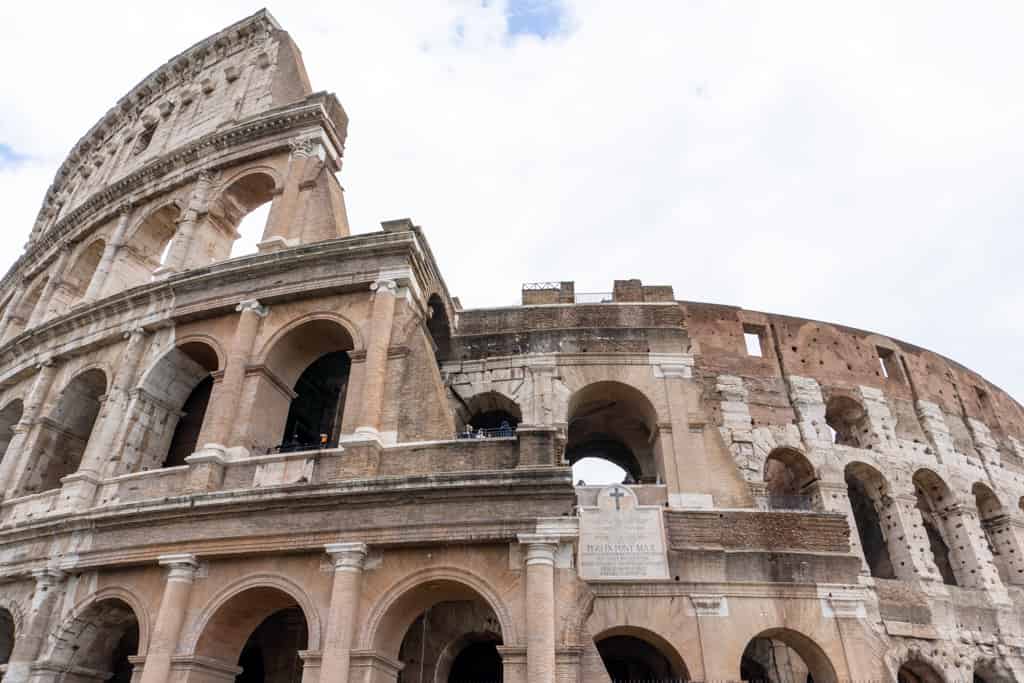
The Colosseum was originally known as the Flavian Amphitheatre, built by the founder of the Flavian dynasty, Emperor Vespasianus in 80 AD.
The building is a perfect example of ancient engineering. Numbered entrance arches and seating in three steep tiers (women and children sat in the highest part). The Colosseum could hold up to 80,000 spectators. A canvas awning overhead provided shade for the audience.
A network of underground passages, or hypogeum, was built under the arena, which served as a pen for animals and an underground entrance for gladiators from the nearby gladiator school.
The Flavian Amphitheatre was the centre of entertainment for the Roman people for more than 500 years – it hosted exotic animal exhibitions, prisoner executions, gladiator fights and was even flooded for mock naval battles. In the Middle Ages, the name of the amphitheatre was changed to the Colosseum to refer to the colossal statue of the Roman emperor Nero that stood nearby.
You might be surprised how much of the Coliseum is missing. This is partly due to disuse and earthquakes, but also the local marble was used to make other buildings. For example, the construction of the Vatican.

If you have a moment, go to the Colosseum in the evening when it is beautifully lit.
- Admission to the Colosseum (including the Forum Romanum and Palatine Hill): full admission €16, reduced admission for EU citizens 18-25 €2, free admission with Roma Pass + €2 for online booking; there is always a €2 fee for online booking
- Free admission for everyone on the first Sunday of the month – no advance reservations possible
- Part of the Roma Pass: yes (more information on where to book with the Roma Pass here)
- Reservations in advance: Not required, but only a limited number of tickets are available on site.
- Opening hours: Jan. 2-Feb. 28, 9 a.m.-3:30 p.m.; March 1-March 25, 9 a.m.-5:30 p.m.; March 26-Aug. 31, 9 a.m.-7:15 p.m.; Sept. 1-Sept. 30, 9 a.m.-7 p.m.; Oct. 1-Oct. 28, 9 a.m.-6:30 p.m.; Oct. 29-Dec. 31, 9 a.m.-4:30 p.m.
- How to get to the Colosseum: metro line B – stop Colosseo, bus – lines 75, 81, 175, 204, 673, tram – line 3
Please note: Children under 18 years of age and disabled persons with an accompanying person are admitted free of charge and can collect their tickets at the ticket offices in the Colosseum or Forum Romanum.
Just opposite the Colosseum you will find the Palatine Hill and the Forum Romanum (both sites form one archaeological park and share a common entrance). As part of your ticket to the Colosseum, you can also visit the Forum Romanum and Palatine Hill. More amazing sights of ancient Rome.
TIP: It’s best to book tickets to the Colosseum in advance if you want to make sure you get in. Book well in advance, they tend to sell out weeks in advance. Guided tours are also available, with which you can learn lots of interesting and fun facts.
For more information, read our previous article on Colosseum in Rome.
Palatine’s hill
Palatine Hill is the mythical birthplace of Rome. According to legend, Romulus founded the city here in 753 BC. Later it became the residence of the imperial palace, rich patricians and celebrity generals. Do you know where the word palace comes from? From the Latin name for a hill or palatium.

Palatine Hill, as we see it today, is mostly made up of ruins from the vast palace of Emperor Domitian. The balcony on the northeast side of the Palatine has a great view of the Roman Forum.
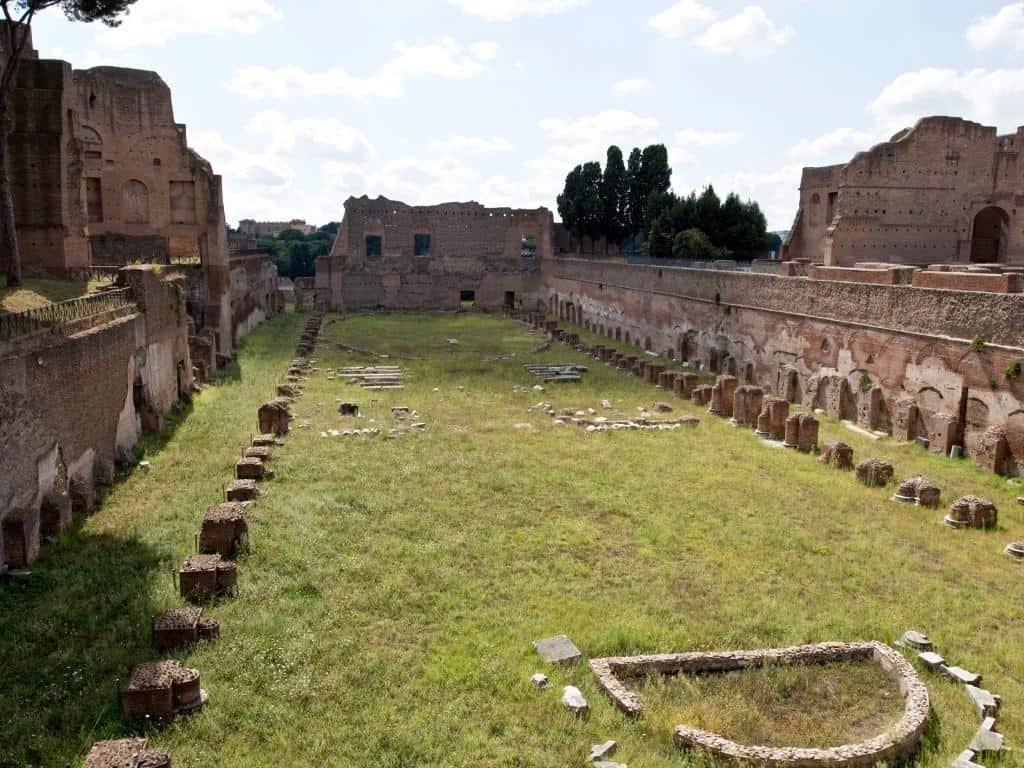
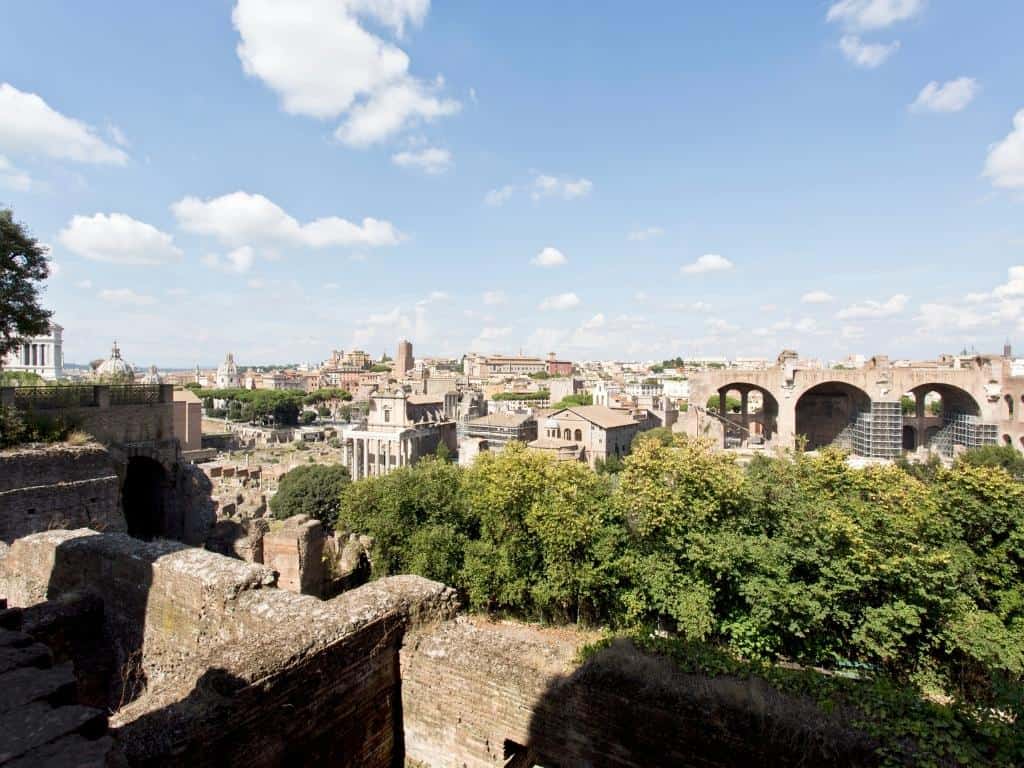
Forum Romanum
The Forum Romanum are the extensive ruins between the Palatine Hill and the Colosseum. In the days of ancient Rome, this was the place to live. A complex of large temples, courts, offices and noisy public squares. Several buildings have been preserved in excellent condition.
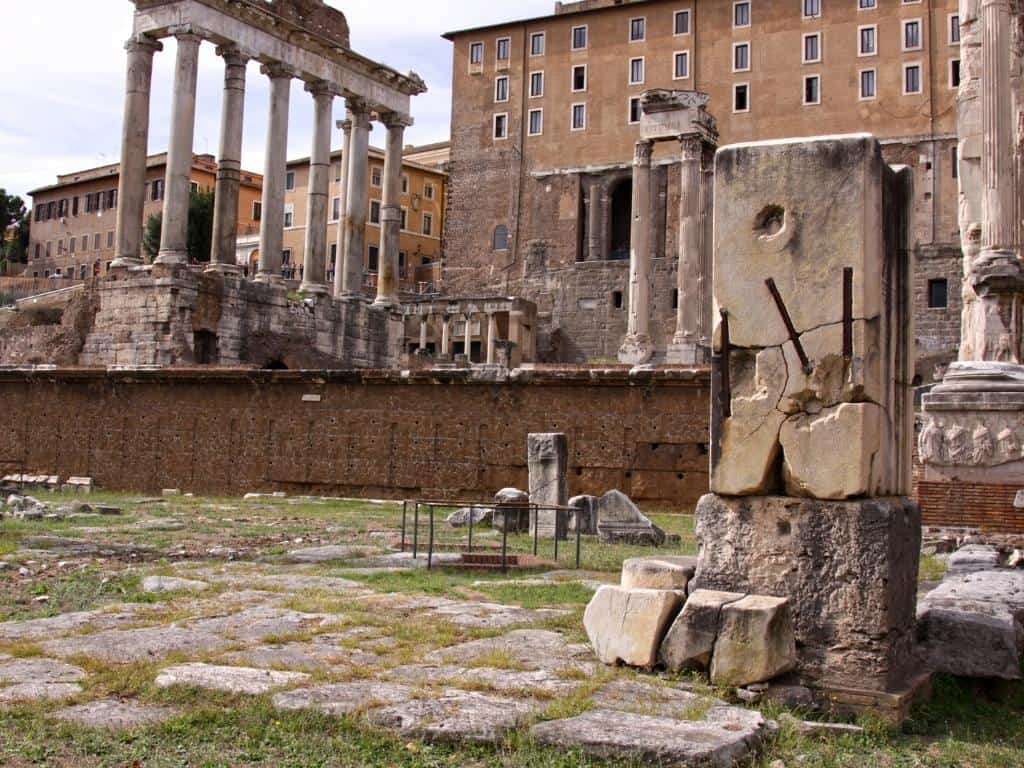
You can admire the Arch of Titus, the original seat of the Roman Senate of Curia, one of the most imposing triumphal arches of Rome, the columns of the Temple of Saturn, the Fortress of Knox, where gold and silver supplies were kept, the Temple of Caesar, where Caesar was burned after his assassination in Largo Argentina in 44 BC.
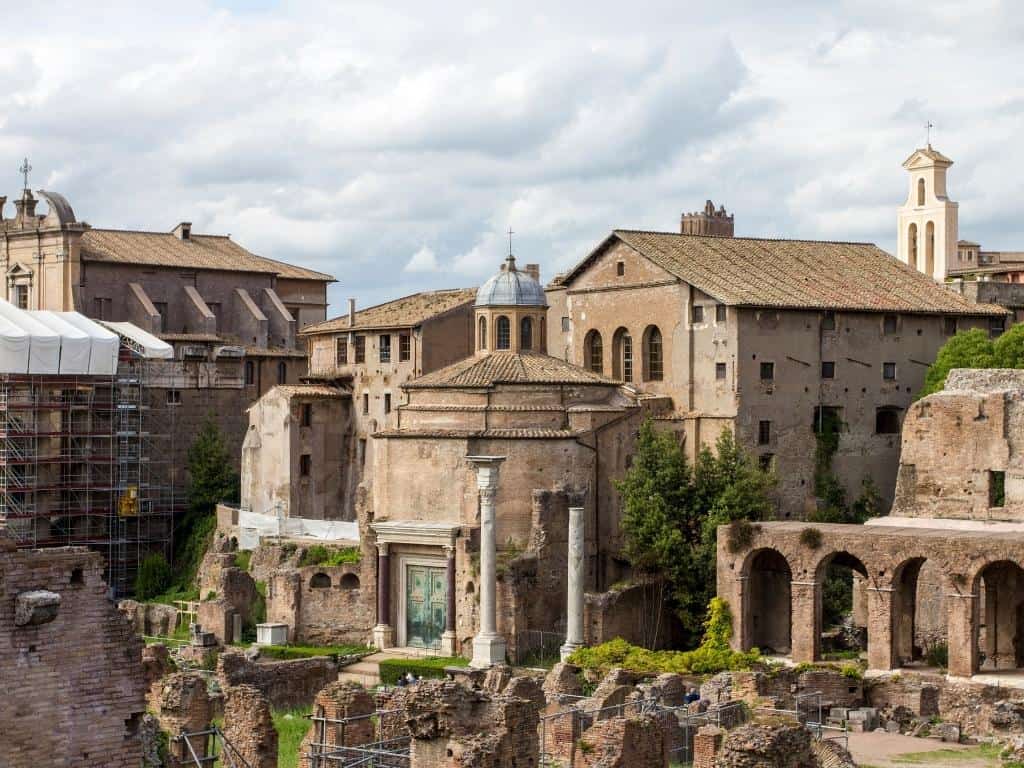
TIP: It’s best to book tickets to the Colosseum in advance if you want to make sure you get in. Book well in advance, they tend to sell out weeks in advance. Guided tours are also available, with which you can learn lots of interesting and fun facts.
You can then print your ticket or simply scan it from your mobile phone at the entrance. At the Colosseum, take the entrance on the right reserved for individuals.
Arch of Constantine
The Arch of Constantine is not to be missed – it is located between the Colosseum and the Palatine Hill. It was built in 315 to commemorate the victory of Constantine I the Great at the Battle of Milvian Bridge. It is freely accessible.
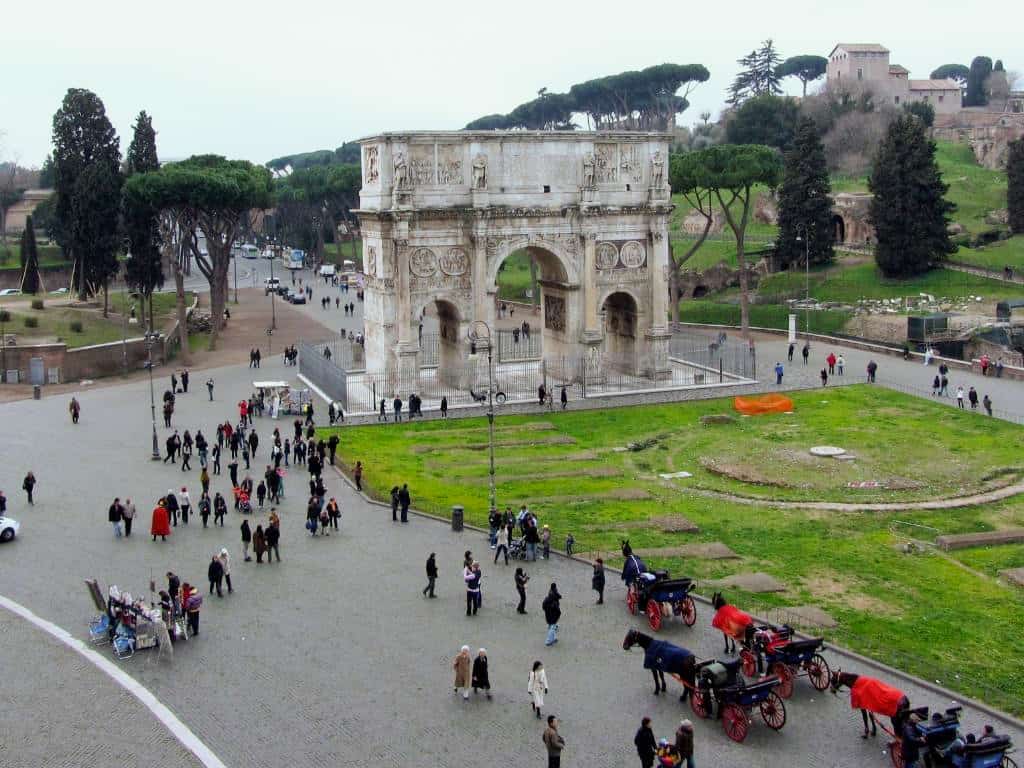
Would you like to save money on entrance fees and transport around Rome? Or do you want to simplify things and use one card for everything? See Roma Pass and Roma and Vatican Passwhich give you free entry to a number of sights, including public transport and sightseeing bus rides. A comparison of the two cards can be found in my previous article.
Circus Maximus
The Circus Maximus is a famous Roman sports venue where chariot races were held. The venue has an area of 600 metres in length and 225 metres in width, so at one time it could accommodate up to 300,000 spectators. The Circus Maximus is adjacent to the Palatine Hill and on the other side is the Aventino Hill.
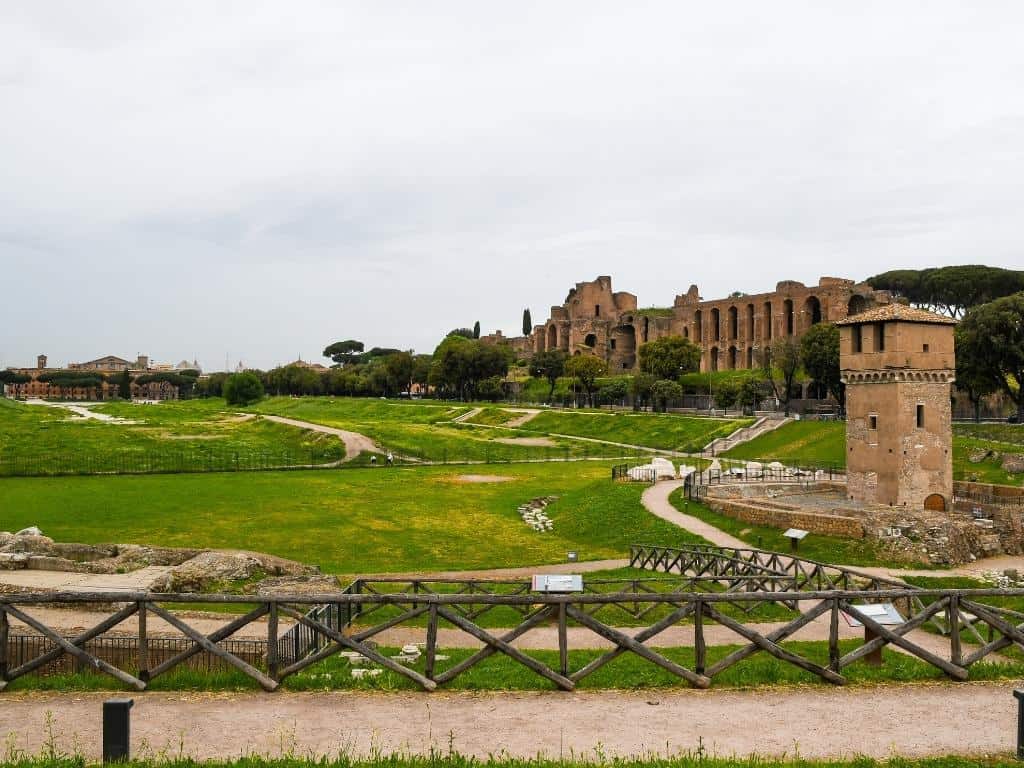
There’s not much left of Circus Maximus. Only the huge terrace remains. You can walk through the park for free, but there is an entrance fee for the archaeological dig.
- Admission: full admission 5 €, reduced admission 4 € (EU citizens 18 – 25 years)
- Opening hours: Tuesday-Sunday 09:30-19:00 in summer, Tuesday-Sunday 9:30-16:30 in winter (late October to March)
- How to get to Circus Maximus? Metro – line B → stop Circo Massimo or 15 minutes walk from the Colosseum (straight ahead after the Arch of Constantine)
- Reservation: no
- Part of the Roma Pass: yes
Baths od Caracalla (Terme di Caracalla)
Caracalla’s baths were built in the 3rd century. Century Marcus Aurelius. In ancient times it was one of the largest and most interesting thermal complexes. The spa included swimming pools, gymnasiums, libraries, galleries, shops and gardens. They can hold up to 1,600 people.
Although they are not well marked and you often don’t know what you are looking at, they are huge enough to give you a good idea of how gigantic they must have been originally.
- Admission: full admission 8 €, reduced admission 2 € (EU citizens 18 – 25 years)
- Free admission for everyone on the first Sunday of the month – no advance reservations possible
- Opening hours: Tuesday-Sunday 09:00-19:00 (varies according to season – exact time to be booked; last entry one hour before)
- How to get: Metro – line B → Circo Massimo stop, bus → lines 118, 160, 628 or 15 minutes on foot from Circus Maximus
- Reservation: not compulsory, but can be booked for an additional fee of 2 € – reservation for Caracalla Spa
- Part of the Roma Pass: yes
Hotels in Rome 😴
Trajan’s Forum – Museo dei Fori Imperiali
Trajan’s Markets (Mercati di Traiano) on the slopes of the Quirinal Hill were the dominant focus of Trajan’s Forum in the early 2nd century. century, which was the last and most spectacular of the imperial forums.
It was originally thought to be an ancient shopping centre, but scientists now believe they were designed to house the forum’s administrative offices.
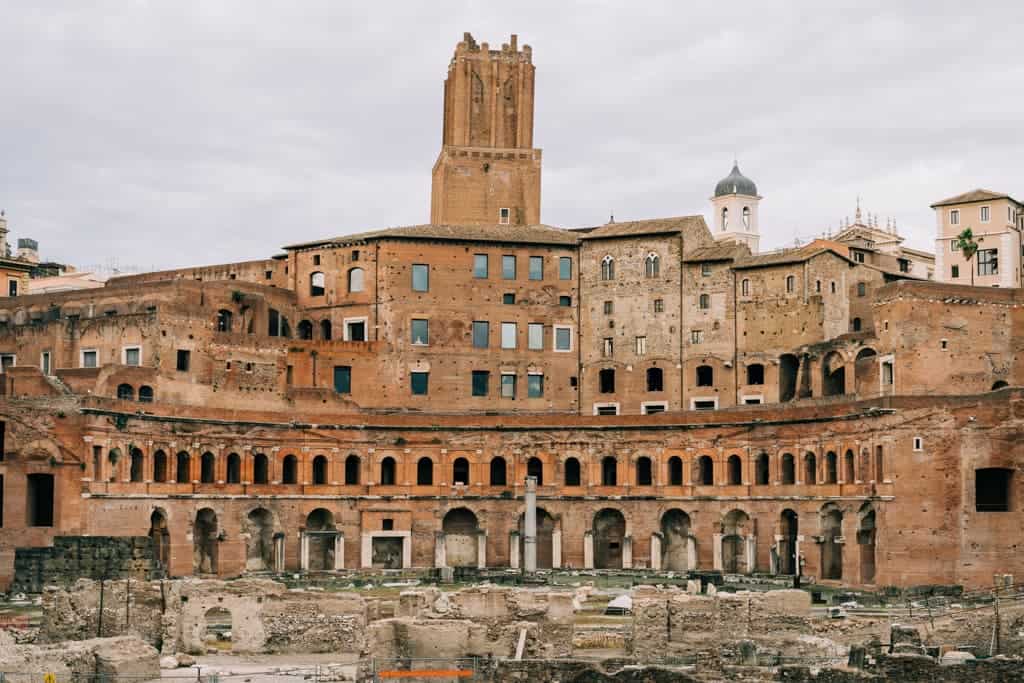
Whatever the case, the building itself is a colossus that will amaze you in person with its size and how well-preserved it has remained over the centuries. A beautiful building that deserves more attention. Plus, it’s only a few minutes from the Colosseum.
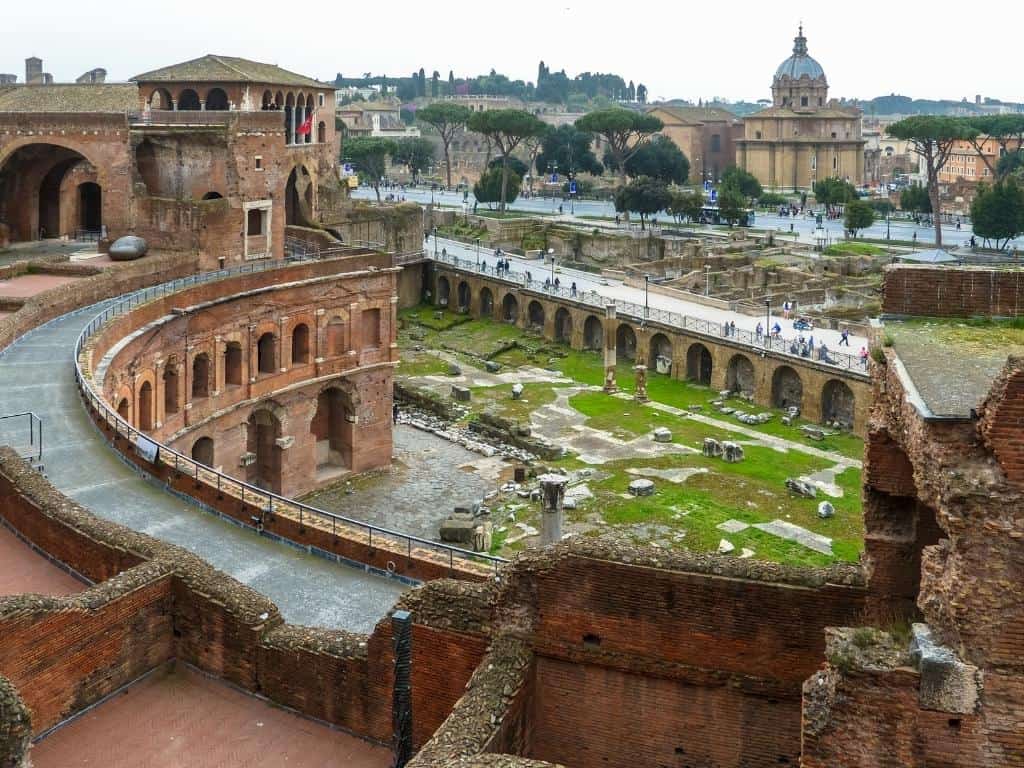
- Admission: full admission 16 €, reduced admission 12 € (EU citizens 18 – 24 years old)
- Opening hours: daily 9:30-19:00
- How to get there: Metro line B → stop Colosseo or Cavour, bus – lines 40, 53, 60, 64, 70, 80, 85, 57, 117, 170, 175, 186, 271, 571, 810, H, N7, N8, N9, N15, N18 → stop Piazza Venezia
- Reservation: no
- Part of the Roma Pass: yes
Angel Castle and Angel Bridge
A short distance from the Vatican, on the right bank of the Tiber River, you will find the Castelo Sant’ Angelo, known as Hadrian’s Tomb. Hadrian was a Roman emperor who had the fortress built in 139 AD as a mausoleum for himself and his family.
The papacy then took it over, fortified it and used the church as its refuge.
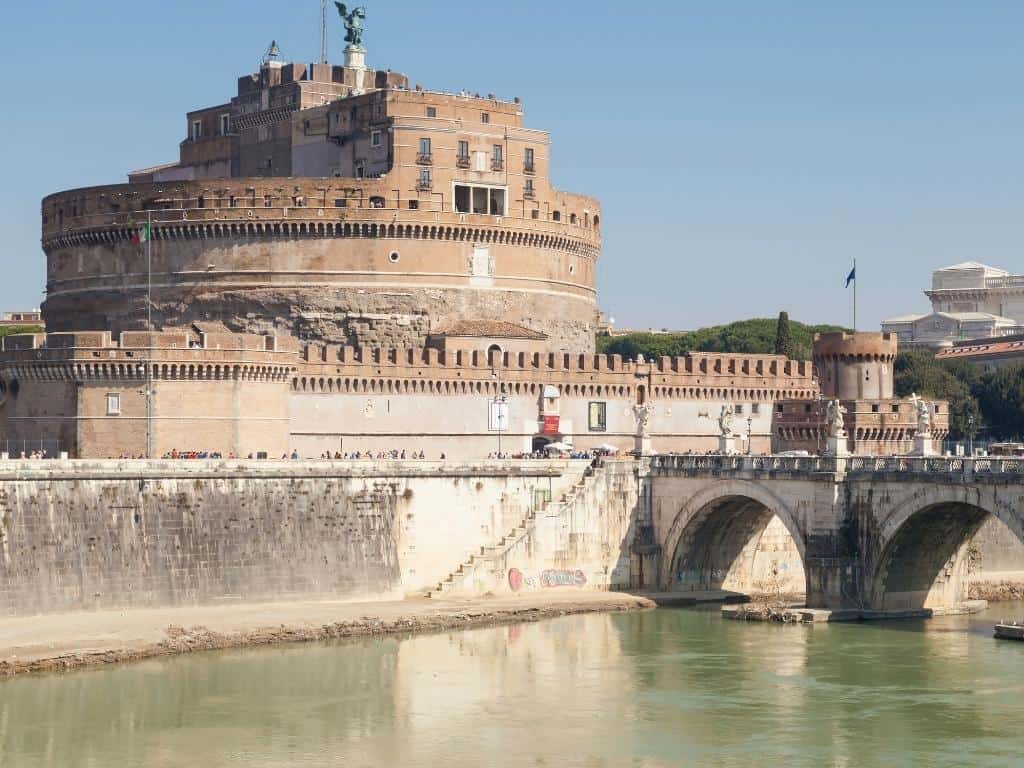
The name of the castle is derived from a vision of an angel that Pope Gregory had here in 590. Today, the Castle of the Angels is a popular museum where you can learn more about its long and turbulent history and experience the lavish papal apartments.

From the Castle of the Angels, continue along the Bridge of Angels (Ponte Sant’Angelo), built by the ancient Romans, but angels have been here since the 1600s. And it is the angels that represent the Stations of the Cross and the 12 stops on the way to the crucifixion of Jesus Christ.
- Admission to Angel Castle: full admission 16 €, reduced admission 3 € (EU citizens 18-24 years old); first Sunday of the month free for all (no reservation needed)
- Opening hours: Tuesday-Sunday 9:00-19:30 (ticket office closes at 18:30)
- How to get to Angel Castle: Bus – lines 23, 34, 49, 64, 87, 280, 492, 926, 990
- Booking: during holidays and weekends it is recommended to book in advance (booking fee € 1). I recommend booking any time of the season from April to October – there are already queues in April.
- Part of the Roma Pass: yes
Pantheon
The Pantheon is a church and mausoleum that in its early days was used for the worship of planetary gods. It is known for its dome, which is the largest dome of unreinforced concrete in the world.
You just stand there and don’t understand how they did it. But they came up with a great idea – as the layers of concrete blocks rose higher and higher, they used lighter and lighter material. So the bricks at the very top are made of extra light pumice.
In the upper part of the dome there is an opening with a diameter of 9 meters, through which, in addition to the door, the only daylight enters the church.

The Pantheon is even the oldest building in the world still in use. This is probably the reason why it has been preserved in such good condition to the present day.

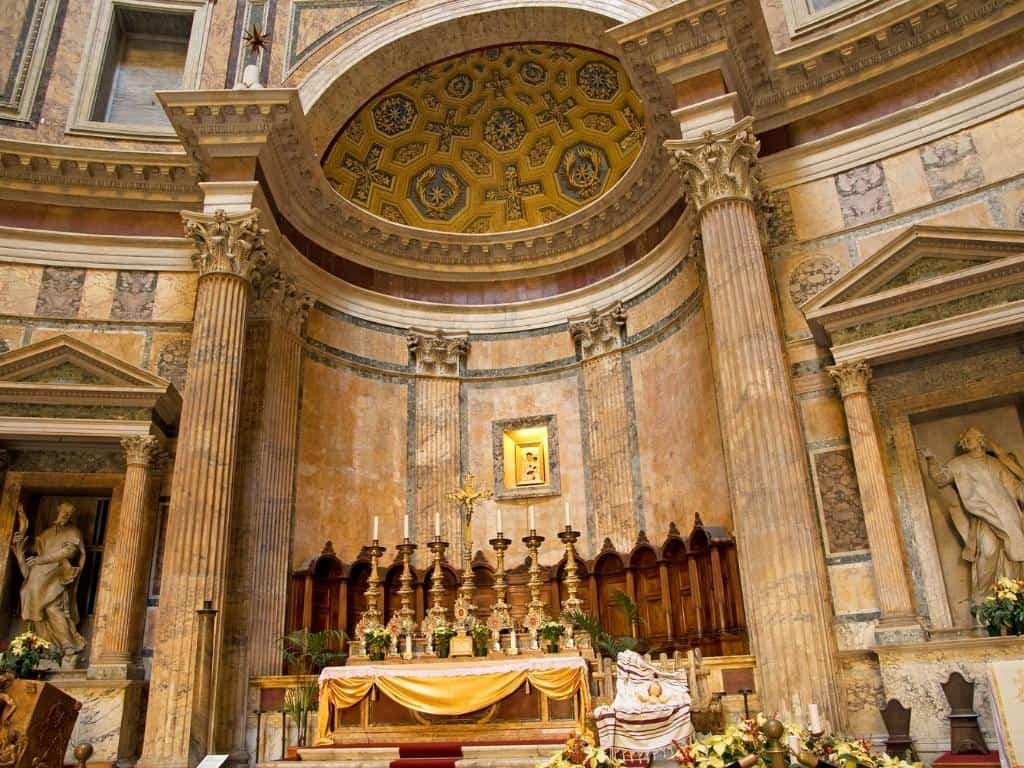
- Where is it? Piazza della Rotonda
- How do I get there? Metro – line A → stop Barberini
- What are the opening hours? Monday-Saturday 8:30 a.m.-7:30 p.m., Sunday 9 a.m.-6 p.m., public holidays 9 a.m.-1:30 p.m. (Last entry 15 minutes before)
- How much is the entry fee? From 3. 7. 2023, there is a fee for entry to the Pantheon. Admission is €5 and a reduced admission of €2 for 18-25 year olds. Free admission on the first Sunday of the month. Reservation is possible here.
Sacra di Largo Argentina
Sacra di Largo Argentina features the ruins of four temples from the Republican period, where Brutus and his conspirators stabbed Julius Caesar to death in 44 BC. Today, the site is a short walk from a busy transport hub and home to a cat sanctuary, which is looked after by a local organisation.
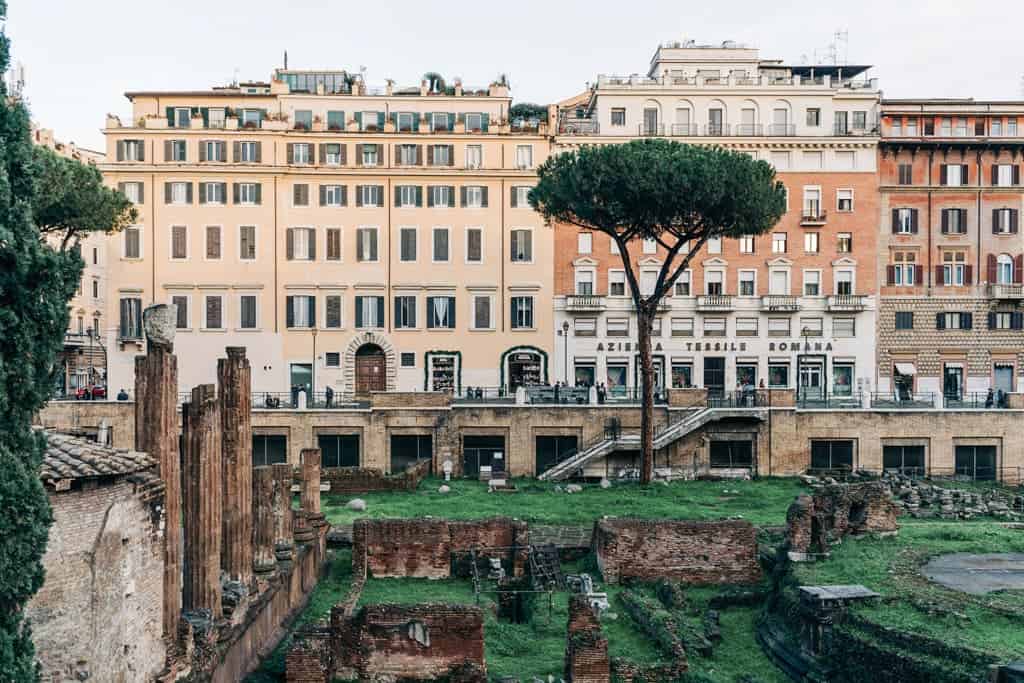
- Where is it? Largo di Torre Argentina
- How do I get there? Buses 40, 46, 62, 64, 70, 81, 87, 186, 492 and 810
- What are the opening hours? Free to view from the railing
- How much is the entry fee? Free
Hotels in Rome 😴
Diocletian’s Baths
Diocletian’s Baths, the historic home of the National Museum of Rome, are very close to Palazzo Massimo. In 4. century, it used to be the largest and most spectacular spa complex in ancient Rome, accommodating up to 3,000 people at a time.
Supposedly, they were even bigger than Caracalla’s baths. Diocletian’s Baths are right next to Termini Central Station.
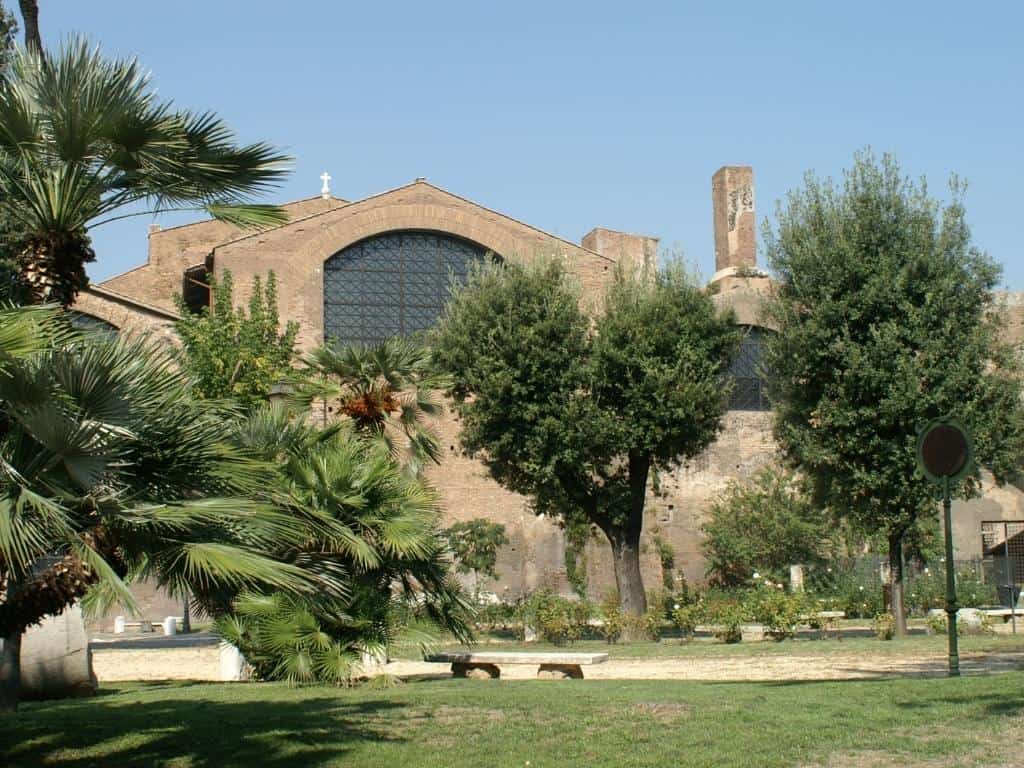
In the museum you can see a collection of ancient Roman inscriptions and written texts. Don’t miss the Church of Santa Maria degli Angeli, designed by Michelangelo, but completed the following year by his pupil Jacopo Lo Duca.
Outside, there is the beautiful open space of the Michelangelo Cloister or Michelangelo Convent. It may not belong to ancient Rome anymore, but it is part of the complex and is definitely worth seeing.
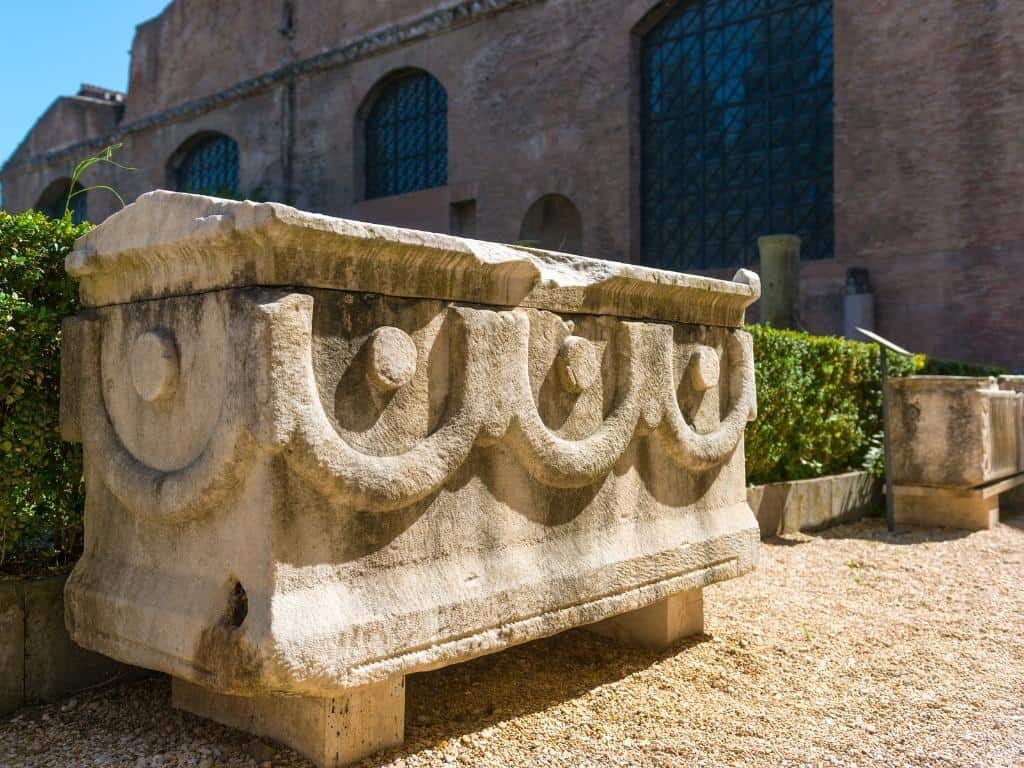
- Where is it? Via Enrico de Nicola, 78
- How do I get there? Metro – line A or B → Termini station, bus C2, H, 36, 38, 40, 64, 86, 90, 92, 105, 170, 175, 217, 310, 360, 714 and 910
- What are the opening hours? Tuesday-Friday 14:00-19:45, Saturday-Sunday 10:30-19:45 (last entry at 19:00)
- How much is the entry fee? 12 € (8 € reduced for EU citizens 18-25 years) as part of the combined ticket for the National Museum of Rome, 8 € (2 € reduced for EU citizens 18-25 years) as part of the regular ticket
- Free admission for everyone on the first Sunday of the month – no advance reservations possible
- Reservation: not required
- Part of the Roma Pass: yes
Basilica of Santa Maria Maggiore
The Basilica of Santa Maria Maggiore is one of the four papal basilicas and one of the oldest basilicas in Rome. You will find it at the site of the miraculous snowfall on top of Esquiline Hill.
According to legend, the Virgin Mary appeared to Pope Liberius and told him to build a church on the spot where he would find snow the next morning. It was summer at the time, so the probability was almost zero. Yet the snow fell here and the basilica was built.
Snowfall is always commemorated on the 5th. May by releasing thousands of white petals.
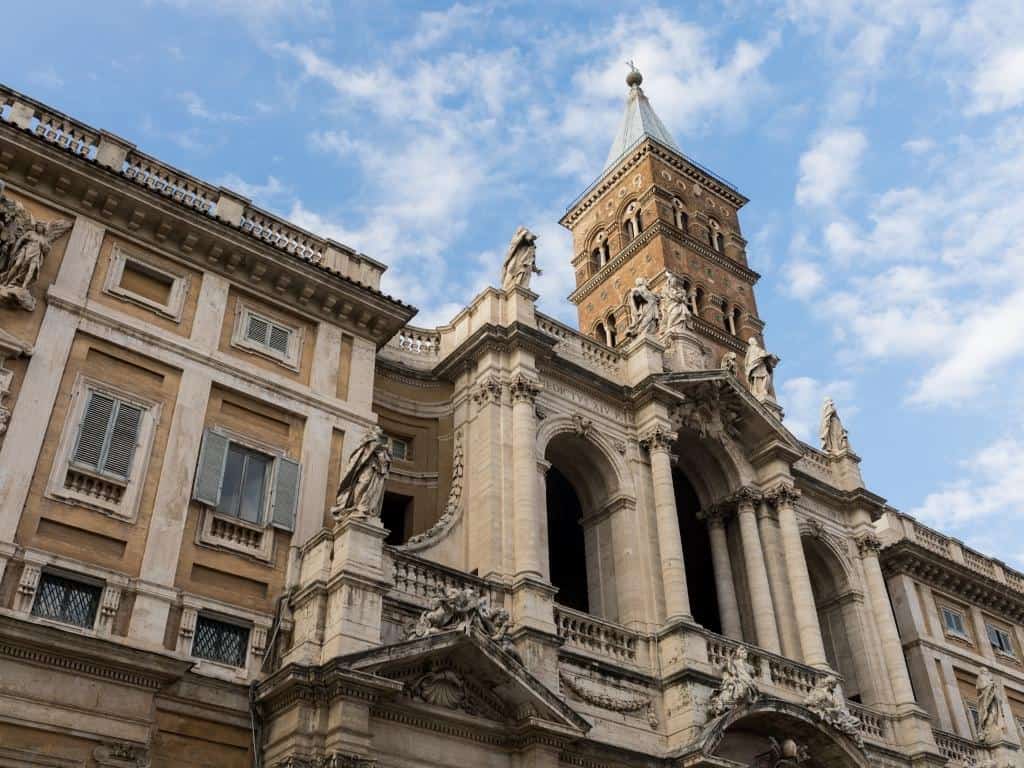
Several popes and the famous artist Gian Lorenzo Bernini were buried in the basilica. The interior of the basilica is decorated with mosaics from 5. century, depicting 36 scenes from the Old Testament.
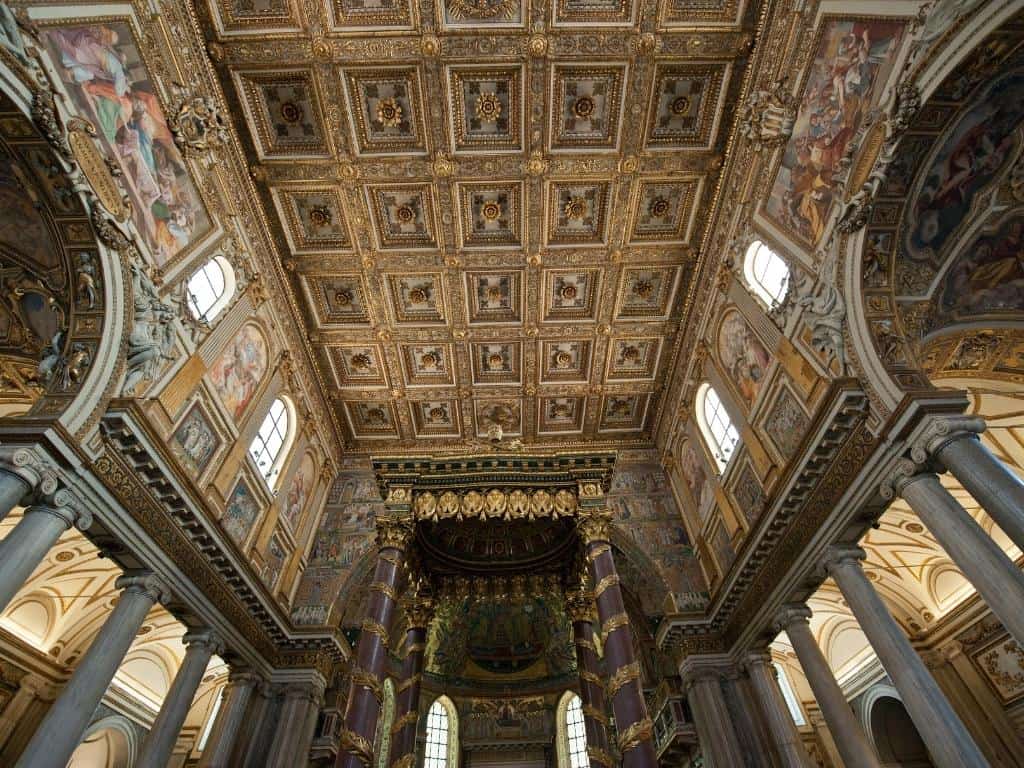
- Where is it? Piazza Santa Maria Maggiore
- How do I get there? Termini metro stop
- What are the opening hours? 7:00-18:45
- How much is the entry fee? Free
- Reservation: no
Via Appia Antica
The ancient Via Appia Antica is over 2000 years old. At that time it was the most famous road in the ancient city. It was 540 km long and connected Rome with the southern Adriatic port of Brindisi. Today, the main attraction is the catacombs that lie beneath it.
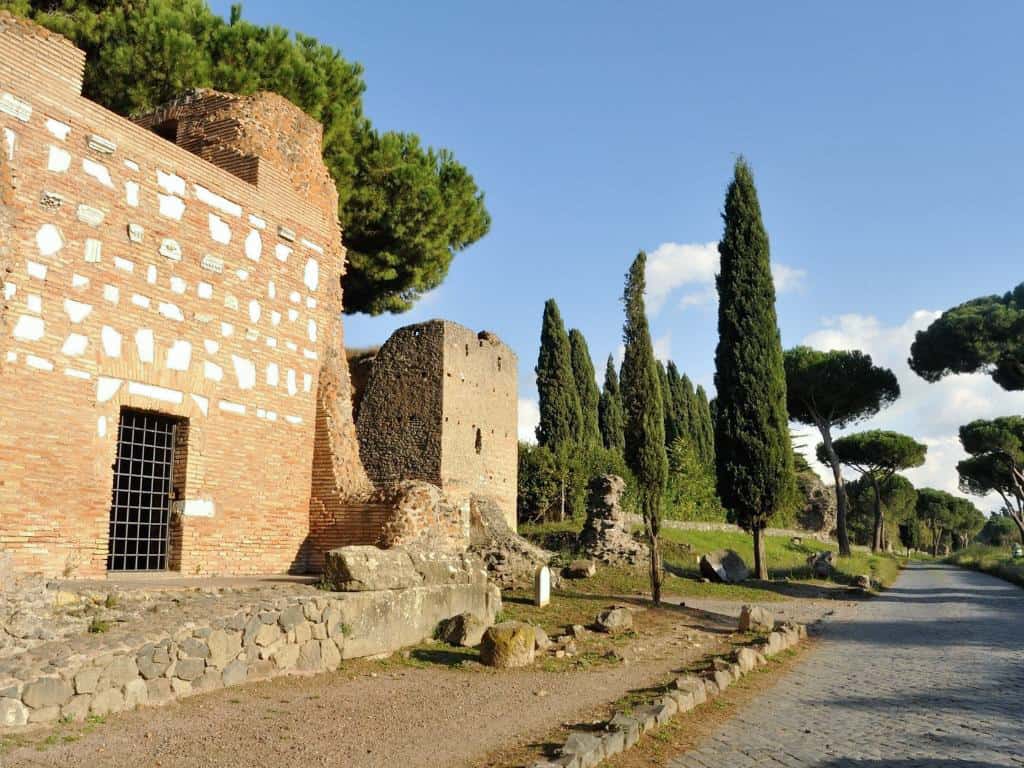
Catacombs of Rome (Catacombe di Roma)
The catacombs are underground passages that were used for centuries as burial grounds for Jewish, pagan and early Christian Roman citizens from the second to the fifth century. Hundreds of thousands of people were buried here, including dozens of martyrs and 16 popes.
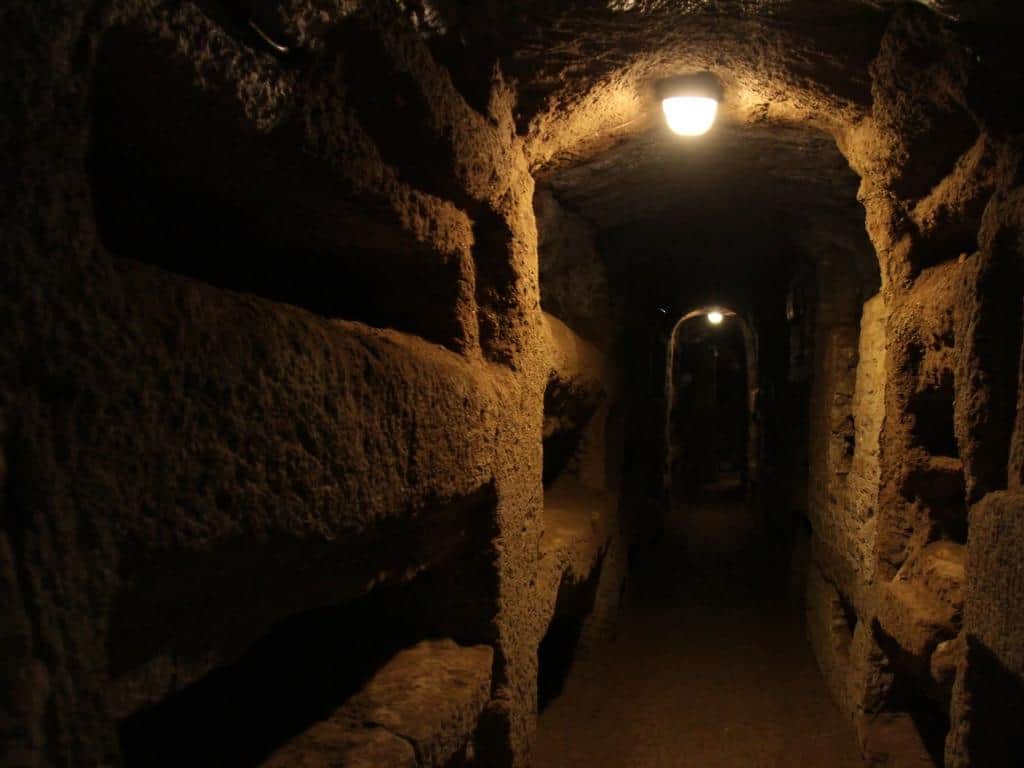
The largest and most popular are the catacombs of San Callisto. Visits here, as in the other catacombs, are guided. Nobody would want to get lost in 20 m long underground tunnels.
Also worth seeing are the catacombs of San Sebastian, which contain several underground mausoleums and lots of ancient graffiti dedicated to St. Peter and Paul.
Not far away is the Basilica of San Sebastiano, which contains one of the arrows used to kill Saint Sebastian.
- Where? For both places the same: Via Appia Antica 110/126
- How? Metro – line A (from Termini train station) → stop Piazza San Giovanni in Lateran – then change to bus 218 (direction Ardeatine) → stop Fosse Ardeatine
- What are the opening hours? Catacombs of San Callisto Monday-Tuesday and Thursday-Sunday 9:00-12:00 and 14:00-17:00, Catacombs of San Sebastian Monday-Saturday 10:00-17:00
- How much is the entry fee? Same for both places: full admission 8 €, reduced admission 5 € (children 7 – 16 years)
Ticket Reservation
Monuments of Ancient Rome – MAP
Most of the monuments of ancient Rome are close to each other – the Baths of Caracalla, the Circus Maximus, the Colosseum, the Forum Romanum, Palatine Hill, Trajan’s Forum and other imperial forums, the Pantheon and the Castle of the Angels. You can easily walk through them.
Diocletian’s Baths are about 40 minutes from the Colosseum or the Pantheon. Right next to Termini Station. You’ll have to go further to reach the catacombs, but if you’re interested in the Roman underground, it’s well worth it. In summer, it is also pleasantly cool.
HOW TO USE THIS MAP: Above you will find a detailed map of museums, monuments and attractions to visit and see in Rome. Click at the top left of the map to see separate layers with highlighted locations. You can hide and show the different layers or click on the icons on the map to see the names of the places I mention in my guide to Rome. If you want to save the map, star it. For a larger version, click on the icon in the upper right corner.
Where to stay in Rome
- Hotel Impero – cheap hotel with excellent breakfast and roof terrace; older facilities but clean and cosy; quiet at night
- Hotel Borromeo – 3* hotel with air conditioning and roof terrace; minutes from the metro and within walking distance of the historic centre
- Hive hotel – 4* hotel with modern and clean rooms; rooms and suites for up to 4 people available; spacious roof terrace with seating and restaurant
- hu Roma Camping in Town – accommodation in air-conditioned bungalows or chalets, restaurant, refreshments, free parking, jacuzzi, swimming pool, bar
Hotels in Rome 😴
These were our picks for sights of ancient Rome. Do you have a question? We will be happy to answer it below. Have a safe journey!
More about Rome
THE BEST PLACES TO VISIT IN ROME: In our article on what to visit in Rome, you will find detailed descriptions of the most beautiful places, including information on admission fees and opening times. We also have special guides for the best museums in Rome.
We’ve created a detailed guide to the Vatican that tells you everything you need to know before your visit.
Read the guides for the Vatican Museums and the Colosseum to avoid queues on site. What not to miss in the Sistine Chapel is covered in a separate article.
Rome Itinerary: Get inspired by our itinerary for Rome in 1 day or Rome in 3 days.
ACCOMMODATION IN ROME: We’ve created a detailed guide on where to stay in Rome (best neighbourhoods and accommodation on a budget, a map and how to get from your accommodation to the sights or the airport).
HOW TO ENJOY ROME: For tips on the best things to do in Rome, check out our article on what in. We also share some tips on how to save in Rome and more than 35 tips for travelling around Rome. In a separate article, you can find out about all the ways to get from Fiumicino Airport to the centre of Rome.
